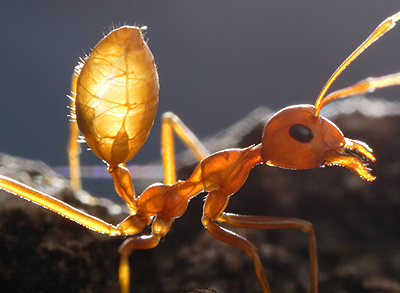Oecophylla weaver ants are exceptionally cooperative subjects for photography, allowing for plenty of experimentation with lighting while the ants preen and pose. While developing the photographs from South Africa I discovered that strong backlighting allows a crystal-clear view of the tracheal system:

Oecophylla longinoda, St. Lucia, KZN, South Africa
The tracheae are visible as dark canals running through the body. These connect to the outside air in a series of circular spiracles and are essentially the lungs of the insect, channeling oxygen to the respiring cells and carrying away carbon dioxide. I never though I'd photograph them in a living insect.
photo details: Canon MP-E 65mm 1-5x macro lens on a Canon 20D
ISO 100, f/11, 1/250 sec
backlight with handheld strobe, 60% crop in PS.
- Log in to post comments
More like this
Among the more charismatic ants I saw during my visit to South Africa was a silver Polyrhachis that seemed all too happy to pose for me. With such an unusually cooperative subject, I was able to experiment with several different arrangements of the flash heads on my MT-24EX twin flash. Compare…
Megacyllene robiniae - Locust Borer
Champaign, Illinois
Goldenrod flowers are a magnet for late summer insects, and among the most spectacular attractions is the locust borer, a wasp-striped longhorn beetle. They gather on the flowers to mate and to feed on pollen.
Megacyllene larvae are pests…
Two male Rhagoletis walnut flies joust on an artificial walnut in a lab cage at the University of Arizona. What's an artificial walnut? It's a painted ping pong ball. As long as the ball is the right color and shape, the flies apparently don't mind.
Biologist Jeremy Davis uses these flies to…
Hololepta Clown Beetle (Histeridae)
Arizona
If Oscars were awarded for Most Aesthetically Pleasing Sculpturing on an Insect, hister beetles would make the short list. Especially Hololepta, which not only shows the trademark histerid shininess but also has a flattened, paper-thin body. Michele…


Wow... this photo is astounding. The effect of the backlighting really adds an awe-inspiring effect to this ant.
one of the most amazing shots i've seen!
Mmm. Much tastier than smaragdina - full of lemony-goodness!
I ate one of these (longinoda) in the Gambia, with our Gambian guide looking on in disbelief. I'm sure he still tells the tale of the crazy white guy who came to eat the ants!
Incredible shot BTW.
Nice shot. Backlighting is indeed very useful for revealing otherwise hidden details. Here is my picture of the lung of a snail, likewise revealed with backlighting.
I agree - an excellent shot, Alex. Perfect use of backlighting.
That's just beautiful.
Curious... Do weaver ants have a thinner cuticle than other ants?
Amazing shot.